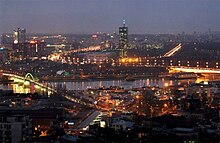Economy of Serbia

New Belgrade, financial center of Serbia.
|
|
| Currency | Serbian dinar (RSD) |
|---|---|
| Calendar year | |
|
Trade organisations
|
CEFTA, BSEC |
| Statistics | |
| GDP |
|
| GDP rank | 58th (nominal) / 79th (PPP) |
|
GDP growth
|
|
|
GDP per capita
|
|
|
GDP by sector
|
services: 51.1% industry: 38.5% agriculture: 10.4% (2015 est.) |
|
|
|
|
Population below poverty line
|
6.2% (2014) |
| 31.7 (2014) | |
|
Labour force
|
2.9 million (2015 est.) |
|
Labour force by occupation
|
services: 62.5% agriculture: 21.9% industry: 15.6% (2014 est.) |
| Unemployment |
|
|
Average gross salary
|
$612 monthly (April 2016) |
|
$447 monthly (April 2016) |
|
|
Main industries
|
motor vehicle, base metals, furniture, food processing, machinery, chemicals, sugar, tires, clothes, pharmaceuticals |
|
|
|
| External | |
| Exports |
|
|
Main export partners
|
|
| Imports |
|
|
Import goods
|
motor vehicles ($2.163bn), oil ($1.808bn), electrical machines ($0.813bn), natural gas ($0.807bn), medical products ($0.700bn) |
|
Main import partners
|
|
|
FDI stock
|
|
|
Gross external debt
|
|
| Public finances | |
|
|
|
| Revenues |
|
| Expenses |
|
| Economic aid | $3.49 billion of EU IPA funding (2001–2014) |
|
|
|
Foreign reserves
|
|
The economy of Serbia is the 84th or 79th largest in the world at $37.739 billion or $107.131 billion by nominal gross domestic product or purchasing power parity respectively. Its economy is mostly based on various services (51.1% of GDP), industry (38.5% of GDP) and agriculture (10.4% of GDP). In the late 1980s, at the beginning of the process of economic transition from a planned economy to a market economy, Serbia's economy had a favorable position, but it was gravely impacted by economic sanctions from 1992 to 1995.
After the ousting of former Yugoslav President Slobodan Milošević in October 2000, the country went through an economic liberalization process, and experienced fast economic growth. GDP per capita (nominal) went from $1,241 in 2000 to $6,123 in 2014. In March 2012, it became a candidate for the European Union. After years of economy decline due to world financial crisis, in 2011, the economy GDP growth was 2%. Serbia entered a second recession in 2012, causing GDP to decline 1.5% for that year. In 2013, Serbia was among the top ten of European countries in regard to GDP growth, which amounted to 2.6% year on year. As of 2016 estimations, the unemployment rate was at 19.3%. Estimated GDP (nominal) for 2016 calendar year is $43.866 billion, which is $6,123 per capita, while the estimated GDP (PPP) is $100.18 billion, which is $14,047 per capita. Since the 1990s, Serbia has experienced a serious "brain drain", especially during the wars at that time; each year, more than 32,000 people emigrate. Despite the loss, the Serbian diaspora's transfers account between 10% and 15% of Serbia's GDP and significantly increase living standards in some parts of the country.
...
Wikipedia
